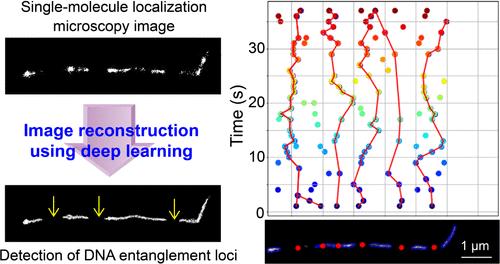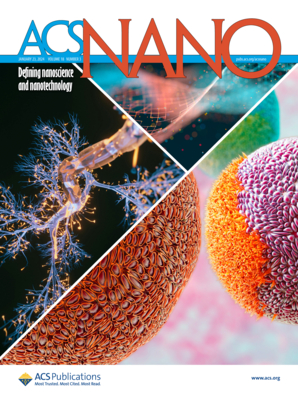Deep Learning and Single-Molecule Localization Microscopy Reveal Nanoscopic Dynamics of DNA Entanglement Loci
IF 15.8
1区 材料科学
Q1 CHEMISTRY, MULTIDISCIPLINARY
引用次数: 0
Abstract
Understanding molecular dynamics at the nanoscale remains challenging due to limitations in the temporal resolution of current imaging techniques. Deep learning integrated with Single-Molecule Localization Microscopy (SMLM) offers opportunities to probe these dynamics. Here, we leverage this integration to reveal entangled polymer dynamics at a fast time scale, which is relatively poorly understood at the single-molecule level. We used Lambda DNA as a model system and modeled their entanglement using the self-avoiding wormlike chain model, generated simulated localizations along the contours, and trained the deep learning algorithm on these simulated images to predict chain contours from sparse localization data. We found that the localizations are heterogeneously distributed along the contours. Our assessments indicated that chain entanglement creates local diffusion barriers for switching buffer molecules, affecting the photoswitching kinetics of fluorescent dyes conjugated to the DNA molecules at discrete DNA segments. Tracking these segments demonstrated stochastic and subdiffusive migration of the entanglement loci. Our approach provides direct visualization of nanoscale polymer dynamics and local molecular environments previously inaccessible to conventional imaging techniques. In addition, our results suggest that the switching kinetics of the fluorophores in SMLM can be used to characterize nanoscopic local environments.

求助全文
约1分钟内获得全文
求助全文
来源期刊

ACS Nano
工程技术-材料科学:综合
CiteScore
26.00
自引率
4.10%
发文量
1627
审稿时长
1.7 months
期刊介绍:
ACS Nano, published monthly, serves as an international forum for comprehensive articles on nanoscience and nanotechnology research at the intersections of chemistry, biology, materials science, physics, and engineering. The journal fosters communication among scientists in these communities, facilitating collaboration, new research opportunities, and advancements through discoveries. ACS Nano covers synthesis, assembly, characterization, theory, and simulation of nanostructures, nanobiotechnology, nanofabrication, methods and tools for nanoscience and nanotechnology, and self- and directed-assembly. Alongside original research articles, it offers thorough reviews, perspectives on cutting-edge research, and discussions envisioning the future of nanoscience and nanotechnology.
 求助内容:
求助内容: 应助结果提醒方式:
应助结果提醒方式:


